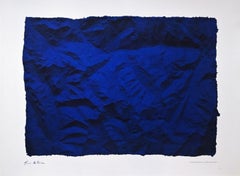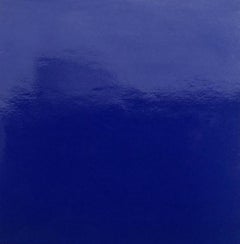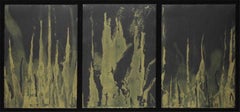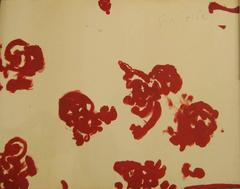Moshe Gershuni Art
to
2
2
2
Overall Height
to
Overall Width
to
2
2
2
6,958
3,340
2,513
1,213
1
1
Artist: Moshe Gershuni
Triptych Israeli Modernist Abstract Gold Paint Prints Bezalel Artist Gershuni
By Moshe Gershuni
Located in Surfside, FL
UNTITLED, 1994, triptych, three etchings on three sheets, each signed and dated and numbered 11/12 on verso, each sheet 11 ½ x 8 ½”, Israeli blind stamp lower right, all in one frame...
Category
20th Century Modern Moshe Gershuni Art
Materials
Mixed Media
Israeli Modernist Bezalel Artist Gershuni Signed Lithograph - Praises & Thanks
By Moshe Gershuni
Located in Surfside, FL
Moshe Gershuni (1936 – 2017) was an Israeli painter and sculptor. In his works, particularly in his paintings from the 1980s, he expressed a position different from the norm, commemorating The Holocaust in Israeli art. In addition, he created in his works a connection between bereavement and homoerotic sexuality, in the way he criticized society and Israeli Zionism-nationalism. He was awarded the Israel Prize for Painting for his work in 2003, but in the end it was revoked and he was deprived of receiving the prize.
Moshe Gershuni was born in 1936 to Yona and Zvi Kutner, who had migrated to British Mandate Palestine from Poland. Zvi, the head of the family, who was an agronomist and farmer,
After his father's death Gershuni began to move into the world of art. The painter Leon Fouturian and the sculptor Uri Shoshany, both residents of Herzliya, influenced him. From 1960 to 1964 he studied sculpture in night courses at Avni Institute of Art and Design, after days spent working in the orchards. His teachers were Dov Feigin and Moshe Sternschuss, members of the “New Horizons” group, which during these years was beginning to lose the central place it had held in the world of Israeli art.
Gershuni’s artistic path began with abstract sculpture, strongly influenced by pop art. His first solo exhibition was mounted in 1969 in the Israel Museum. On the walls of the Museum were hung yellowish green abstract paintings in a geometric style, and throughout the space of the exhibition itself were strewn objects made of soft materials influenced by the Pop Art sculptor Claes Oldenburg. Following the lead of Yitzhak Danziger, the spiritual father of many young artists of the 1970s, Gershuni participated in several performance art installations, which were called in those days "activities." Gershuni developed in a kind of group that worked in the Hadera area, and which included Micha Ullman, Avital Geva, and Yehezkel Yardeni. The group made sure they had regular meetings with Danziger in Haifa and Tel Aviv and participated in tours he organized.
In 1972 Gershuni began to teach in the Department of Fine Arts of “Bezalel.” He was considered one of the central teachers, who supported experimental and political art. In 1978 Gershuni began to teach at HaMidrasha - The Art Teachers Training College in Ramat Hasharon, where he continued to teach until 1986.
In 1979 a solo exhibition entitled “Little Red Sealings” opened at the “Sarah Levy Gallery.” The exhibition included paper and photographs that had been treated with red paint, a color which was to become significant in Moshe Gershuni’s work in the coming years. The works exhibited a number of artistic influences by citing the names of artists such as the Italian sculptor Medardo Rosso, the Israeli painter Aviva Uri, etc.
At the end of this decade Gershuni went through a depression and a deep identity crisis. It was during this period that Gershuni also came to terms with his homosexuality. In 1981, after several sexual experiments with men, Gershuni left his family and Ra'anana for an apartment and studio on Yosef ha-Nasi Street in Tel Aviv-Yafo.
In addition to his expressive works, Gershuni began work on a large number of prints which he created at the Jerusalem Print Workshop. Among his works in this medium that stand out are the series of etchings called “Kaddish” (1984), each of which includes words from the Jewish prayer of mourning Kaddish, a series of prints from the poems of Hayim Nahman Bialik (1986), etc.
In 1986 a large exhibition of Gershuni's paintings, curated by Zalmona, was held in the Israel Museum.
In 1990 a large solo exhibition of Gershuni's works, entitled “Works, 1987-1990” and curated by Itamar Levy, was held at the Tel Aviv Museum of Art.
In May 1996 Gershuni held a joint exhibition with Raffi Lavie in the Givon Gallery in Tel Aviv. The exhibition was considered one of the most important exhibitions of its time, not only because it presented a body of works of two canonical figures in Israeli art, or as it was defined, of “local masters turning 60,” but primarily because of its relationship to Israeli public space.
Gershuni displayed works in a group exhibition called “After Rabin: New Works in Israeli Art” in 1998 at the Jewish Museum in New York City.
In November 2010, a retrospective exhibition of Gershuni’s works opened at the Tel Aviv Museum of Art, curated by Sarah Breitberg-Semel. Another exhibition of his works from the 1980s onward opened in November 2014 at the Neue Nationalgalerie in Berlin, Germany.
Gershuni died on 22 January 2017 in Tel Aviv at the age of 80.
Awards and recognition
1969 Aika...
Category
20th Century Modern Moshe Gershuni Art
Materials
Lithograph
Related Items
Blue Planetary Relief (RP6), 1961, 2015 (Certified by Yves Klein Archives) 35/50
By Yves Klein
Located in New York, NY
Yves Klein (after)
Untitled Blue Planetary Relief (RP6), 1961, 2015
(Certified by Yves Klein Archives), 2015
Color Inkjet Print
29 3/4 × 39 3/4 inc...
Category
Mid-20th Century Modern Moshe Gershuni Art
Materials
Inkjet, Mixed Media, Pencil
La Conférence à la Sorbonne, 3 Juin, 1959, Lt Ed Silkscreen cover record albums
By Yves Klein
Located in New York, NY
Yves Klein
La Conférence à la Sorbonne, 3 Juin, 1959, 1959-1963
Two 12-inch vinyl records held in gatefold sleeve with silkscreen cover jacket in IKB International Klein Blue...
Category
1960s Modern Moshe Gershuni Art
Materials
Plastic, Mixed Media, Screen, Offset, Pencil, Board, Lithograph
No Reserve
H 12.7 in W 12.7 in D 2 in
My Love We Wont - coveted, whimsical 1960s silkscreen by beloved female artist
By Niki de Saint Phalle
Located in New York, NY
Niki de Saint Phalle
My Love We Wont, 1968
Lithograph and silkscreen on wove paper
Signed and numbered 51/75 in graphite pencil on the front
Frame included: elegantly floated and framed in a museum quality white wood frame with UV plexiglass
From the Brooklyn Museum, which has an edition of this work in its permanent collection:
"Throughout her long and prolific career Niki de Saint Phalle, a former cover model for Life magazine and French Vogue, investigated feminine archetypes and women’s societal roles. Her Nanas, bold, sexy sculptures...
Category
1960s Modern Moshe Gershuni Art
Materials
Screen, Mixed Media, Lithograph, Pencil
Still Life - Original Lithograph by Emmanuel Poirier - 1950s
Located in Roma, IT
Still Life is an original lithograph on ivory paper realized in 1950s by Emanuel Poirier.
Signed on the lower left. Edition " E.A." (artist proof).
T...
Category
1950s Modern Moshe Gershuni Art
Materials
Lithograph
H 14.97 in W 11.03 in D 0.04 in
Surrealist Dream - Original Lithograph Signed in the Plate
By Le Corbusier
Located in Paris, FR
Le Corbusier (1887-1965)
Surralist dream, 1963
Original lithograph
Signed and dated in the plate
On paper size 59.5 x 49 cm
Very good condition
Category
1960s Modern Moshe Gershuni Art
Materials
Lithograph
Les Senteurs II, Mixed Media on Paper by Pierre Marie Brisson
By Pierre Marie Brisson
Located in Long Island City, NY
Les Senteurs II by Pierre Marie Brisson, French (1955)
Date: 2002
Mixed Media Print on Handmade Paper, signed and numbered in pencil
Edition of 30/30
Image Size: 30.5 x 30.5 inches
S...
Category
Early 2000s Modern Moshe Gershuni Art
Materials
Mixed Media, Handmade Paper
Composition in Black - Lithograph
By Eduardo Chillida
Located in Paris, FR
Eduardo CHILLIDA (after)
Composition in Black
Lithograph
Signed in the plate
On kraft paper 81 x 55,5 cm (c. 32 x 22 in)
Excellent condition
Category
Late 20th Century American Modern Moshe Gershuni Art
Materials
Lithograph
Niki de St Phalle Bespoke LOVE Shopping Bag
By Niki de Saint Phalle
Located in New York, NY
Niki de Saint Phalle
Niki de St Phalle Bespoke LOVE Shopping Bag, ca. 1982
Silkscreen on paper bag
9.5 x 8 inches
Unframed
The edition is unknown but we h...
Category
1980s Modern Moshe Gershuni Art
Materials
Paper, Mixed Media, Screen
Tricks
By Wifredo Lam
Located in Genève, GE
ED: 22/60
Work on paper
Golden wooden frame with glass pane
Category
Late 20th Century Modern Moshe Gershuni Art
Materials
Lithograph
Les Portraits Imaginaires: One Plate
By Pablo Picasso
Located in London, GB
Lithograph in colours, 1969, on wove paper, with the artist's printed signature as issued, inscribed ‘Hors Commerce’, aside from the French ‘F’ edition o...
Category
1960s Modern Moshe Gershuni Art
Materials
Lithograph
Rainbow Signed 1970s silkscreen & lithograph by pioneering female Fluxus artist
By Mary Bauermeister
Located in New York, NY
Mary Bauermeister
Rainbow, 1973
Lithograph and silkscreen on creamy white paper
Hand signed, dated and numbered 56/250 by the artist on the front
19 x 25.5 inches
Unframed
This work is on the permanent collection of various institutions like: Rice University, Samuel Dorksy Museum of Art, Rutgers Zimmerli Museum and Wheaton College Massachusetts.
While studying the fringe sciences the 1970s, Bauermeister created Rainbow (1973), a lithograph and silkscreen. She uses a creamy white background as the base. Two intersecting diagonal bands of color transcend across the page, and black cursive lettering dances over the surface serving as a mind map of interweaving ideas. Through the central band, Bauermeister shifts through the color spectrum; she begins with red and finishes with violet. Inspired by music, she uses strokes of color that are rhythmically smeared across the lithograph.
The surface lettering, a kind of visual poetry, explores her interest in human emotion and science. The viewer can see Bauermeister’s thoughts as they flow into one another through the use of words such as bliss, love, and healing. Bauermeister also includes a repetition of words such as cancer, sickness, and cure. The word cancer emerges from a cell-like shape. A careful study of the words shows that they may seem dark in nature; however, she juxtaposes these words against the cheerful title and colors. Perhaps the rainbow symbolizes a new hope, an inspiration for an optimistic future.
-Courtesy to the Samuel Dorsky Museum of Art
About Mary Bauermeister:
A multidisciplinary artist known for her intricate and enigmatic assemblages, Mary Bauermeister (1934-2023) continues to defy categorization with layered works in a range of media. A precursory figure of the Fluxus movement—her studio was the meeting point for a number of defining artists of the avant-garde—her work plays an integral role in the discussion of art, both European and American, that emerged from the 1960s. Her reliefs and sculptures, which have incorporated drawing, text, found objects, natural materials and fabric, reference a plethora of concepts: from natural phenomena and astronomy to mathematics and language, as well as her own “spiritual-metaphysical experiences.” Maturing amidst the currents of Minimalism and Pop Art, Bauermeister’s art has resisted labels due to the singular expression of her interests and concerns, among them the simultaneous transience and permanence of the natural world with experimentations in transparency and magnification, multiplication and variation, structure and order, chance and ephemerality, introversion and extroversion. Her three-dimensional receptacles of thoughts, ideas, and notes contain visual, conceptual, and philosophical paradoxes that challenge perceptions and that offer literal and metaphorical windows into which one can glimpse the inner workings of the artist’s mind.
- Courtesy of Michael Rosenfeld...
Category
1970s Modern Moshe Gershuni Art
Materials
Lithograph, Screen, Mixed Media, Pencil, Graphite
Les Portraits Imaginaires: One Plate
By Pablo Picasso
Located in London, GB
Lithograph in colours, 1969, on wove paper, with the artist's printed signature as issued, numbered from the French edition of 250 and inscribed with an ‘F’(there was also an America...
Category
1960s Modern Moshe Gershuni Art
Materials
Lithograph
Previously Available Items
Triptych Israeli Modernist Abstract Gold Paint Prints Bezalel Artist Gershuni
By Moshe Gershuni
Located in Surfside, FL
UNTITLED, 1994, triptych, three etchings on three sheets, each signed and dated and numbered 11/12 on verso, each sheet 11 ½ x 8 ½”, Israeli blind stamp lower right, all in one frame. Provenance: Michael Hittleman Gallery Los Angeles.
Moshe Gershuni (1936 – 2017) was an Israeli painter and sculptor. In his works, particularly in his paintings from the 1980s, he expressed a position different from the norm, commemorating The Holocaust in Israeli art. In addition, he created in his works a connection between bereavement and homoerotic sexuality, in the way he criticized society and Israeli Zionism-nationalism. He was awarded the Israel Prize for Painting for his work in 2003, but in the end it was revoked and he was deprived of receiving the prize.
Moshe Gershuni was born in 1936 to Yona and Zvi Kutner, who had migrated to British Mandate Palestine from Poland. Zvi, the head of the family, who was an agronomist and farmer,
After his father's death Gershuni began to move into the world of art. The painter Leon Fouturian and the sculptor Uri Shoshany, both residents of Herzliya, influenced him. From 1960 to 1964 he studied sculpture in night courses at Avni Institute of Art and Design, after days spent working in the orchards. His teachers were Dov Feigin and Moshe Sternschuss, members of the “New Horizons” group, which during these years was beginning to lose the central place it had held in the world of Israeli art.
Gershuni’s artistic path began with abstract sculpture, strongly influenced by pop art. His first solo exhibition was mounted in 1969 in the Israel Museum. On the walls of the Museum were hung yellowish green abstract paintings in a geometric style, and throughout the space of the exhibition itself were strewn objects made of soft materials influenced by the Pop Art sculptor Claes Oldenburg. Following the lead of Yitzhak Danziger, the spiritual father of many young artists of the 1970s, Gershuni participated in several performance art installations, which were called in those days "activities." Gershuni developed in a kind of group that worked in the Hadera area, and which included Micha Ullman, Avital Geva, and Yehezkel Yardeni. The group made sure they had regular meetings with Danziger in Haifa and Tel Aviv and participated in tours he organized.
In 1972 Gershuni began to teach in the Department of Fine Arts of “Bezalel.” He was considered one of the central teachers, who supported experimental and political art. In 1978 Gershuni began to teach at HaMidrasha - The Art Teachers Training College in Ramat Hasharon, where he continued to teach until 1986.
In 1979 a solo exhibition entitled “Little Red Sealings” opened at the “Sarah Levy Gallery.” The exhibition included paper and photographs that had been treated with red paint, a color which was to become significant in Moshe Gershuni’s work in the coming years. The works exhibited a number of artistic influences by citing the names of artists such as the Italian sculptor Medardo Rosso, the Israeli painter Aviva Uri, etc.
At the end of this decade Gershuni went through a depression and a deep identity crisis. It was during this period that Gershuni also came to terms with his homosexuality. In 1981, after several sexual experiments with men, Gershuni left his family and Ra'anana for an apartment and studio on Yosef ha-Nasi Street in Tel Aviv-Yafo.
In addition to his expressive works, Gershuni began work on a large number of prints which he created at the Jerusalem Print Workshop. Among his works in this medium that stand out are the series of etchings called “Kaddish” (1984), each of which includes words from the Jewish prayer of mourning Kaddish, a series of prints from the poems of Hayim Nahman Bialik (1986), etc.
In 1986 a large exhibition of Gershuni's paintings, curated by Zalmona, was held in the Israel Museum.
In 1990 a large solo exhibition of Gershuni's works, entitled “Works, 1987-1990” and curated by Itamar Levy, was held at the Tel Aviv Museum of Art.
In May 1996 Gershuni held a joint exhibition with Raffi Lavie in the Givon Gallery in Tel Aviv. The exhibition was considered one of the most important exhibitions of its time, not only because it presented a body of works of two canonical figures in Israeli art, or as it was defined, of “local masters turning 60,” but primarily because of its relationship to Israeli public space.
Gershuni displayed works in a group exhibition called “After Rabin: New Works in Israeli Art” in 1998 at the Jewish Museum in New York City.
In November 2010, a retrospective exhibition of Gershuni’s works opened at the Tel Aviv Museum of Art, curated by Sarah Breitberg-Semel. Another exhibition of his works from the 1980s onward opened in November 2014 at the Neue Nationalgalerie in Berlin, Germany.
Gershuni died on 22 January 2017 in Tel Aviv at the age of 80.
Awards and recognition
1969 Aika Brown...
Category
20th Century Modern Moshe Gershuni Art
Materials
Mixed Media
Abstract
By Moshe Gershuni
Located in New York, NY
Moshe Gershuni (born September 11, 1936) is an Israeli painter and sculptor. In his works, particularly in his paintings from the 1980s, he expressed a position different from the no...
Category
1970s Abstract Moshe Gershuni Art
Materials
Lithograph
Moshe Gershuni art for sale on 1stDibs.
Find a wide variety of authentic Moshe Gershuni art available for sale on 1stDibs. You can also browse by medium to find art by Moshe Gershuni in lithograph, mixed media and more. Much of the original work by this artist or collective was created during the 20th century and is mostly associated with the modern style. Not every interior allows for large Moshe Gershuni art, so small editions measuring 34 inches across are available. Customers who are interested in this artist might also find the work of Nissan Engel, Yosl Bergner, and Reuven Rubin. Moshe Gershuni art prices can differ depending upon medium, time period and other attributes. On 1stDibs, the price for these items starts at $500 and tops out at $1,750, while the average work can sell for $1,125.





